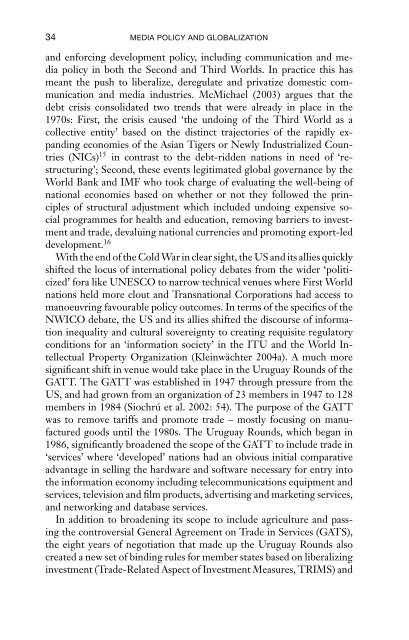Media Policy and Globalization - Blogs Unpad
Media Policy and Globalization - Blogs Unpad
Media Policy and Globalization - Blogs Unpad
Create successful ePaper yourself
Turn your PDF publications into a flip-book with our unique Google optimized e-Paper software.
34 MEDIA POLICY AND GLOBALIZATION<br />
<strong>and</strong> enforcing development policy, including communication <strong>and</strong> media<br />
policy in both the Second <strong>and</strong> Third Worlds. In practice this has<br />
meant the push to liberalize, deregulate <strong>and</strong> privatize domestic communication<br />
<strong>and</strong> media industries. McMichael (2003) argues that the<br />
debt crisis consolidated two trends that were already in place in the<br />
1970s: First, the crisis caused ‘the undoing of the Third World as a<br />
collective entity’ based on the distinct trajectories of the rapidly exp<strong>and</strong>ing<br />
economies of the Asian Tigers or Newly Industrialized Countries<br />
(NICs) 15 in contrast to the debt-ridden nations in need of ‘restructuring’;<br />
Second, these events legitimated global governance by the<br />
World Bank <strong>and</strong> IMF who took charge of evaluating the well-being of<br />
national economies based on whether or not they followed the principles<br />
of structural adjustment which included undoing expensive social<br />
programmes for health <strong>and</strong> education, removing barriers to investment<br />
<strong>and</strong> trade, devaluing national currencies <strong>and</strong> promoting export-led<br />
development. 16<br />
With the end of the Cold War in clear sight, the US <strong>and</strong> its allies quickly<br />
shifted the locus of international policy debates from the wider ‘politicized’<br />
fora like UNESCO to narrow technical venues where First World<br />
nations held more clout <strong>and</strong> Transnational Corporations had access to<br />
manoeuvring favourable policy outcomes. In terms of the specifics of the<br />
NWICO debate, the US <strong>and</strong> its allies shifted the discourse of information<br />
inequality <strong>and</strong> cultural sovereignty to creating requisite regulatory<br />
conditions for an ‘information society’ in the ITU <strong>and</strong> the World Intellectual<br />
Property Organization (Kleinwächter 2004a). A much more<br />
significant shift in venue would take place in the Uruguay Rounds of the<br />
GATT. The GATT was established in 1947 through pressure from the<br />
US, <strong>and</strong> had grown from an organization of 23 members in 1947 to 128<br />
members in 1984 (Siochrú et al. 2002: 54). The purpose of the GATT<br />
was to remove tariffs <strong>and</strong> promote trade – mostly focusing on manufactured<br />
goods until the 1980s. The Uruguay Rounds, which began in<br />
1986, significantly broadened the scope of the GATT to include trade in<br />
‘services’ where ‘developed’ nations had an obvious initial comparative<br />
advantage in selling the hardware <strong>and</strong> software necessary for entry into<br />
the information economy including telecommunications equipment <strong>and</strong><br />
services, television <strong>and</strong> film products, advertising <strong>and</strong> marketing services,<br />
<strong>and</strong> networking <strong>and</strong> database services.<br />
In addition to broadening its scope to include agriculture <strong>and</strong> passing<br />
the controversial General Agreement on Trade in Services (GATS),<br />
the eight years of negotiation that made up the Uruguay Rounds also<br />
created a new set of binding rules for member states based on liberalizing<br />
investment (Trade-Related Aspect of Investment Measures, TRIMS) <strong>and</strong>

















